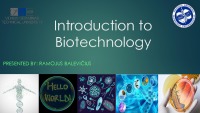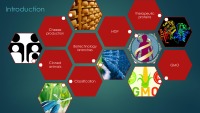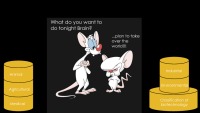Introduction To Biotechnology



Introduction to Biotechnology. Biotechnology -? Biotechnology branches. Blue biotechnology. Red biotechnology. Yellow biotechnology. Gray biotechnology. Brown biotechnology. Violet biotechnology. Black biotechnology. Industrial biotechnology. Therapeutic proteins. Manufacture of cheese in industry. Also, we can get curd when we put hydrolytic enzymes (lactase) into milk. More about cheese, more about biology. How we get GMO? We have a solution! ! ! Genetically modified, insect resistant corn. Animal cloning. Animals That Have Been Successfully Cloned by Scientists. Conclusions. History of biotechnology. Ancient biotechnology. Modern biotechnology. Human genome project HGP. Major scientific discoveries in biotechnology. Ethical issues. Future of of biotechnology.
What do you want to do tonight Brain?
The exploitation of biological processes for industrial and other purposes, especially the genetic manipulation of microorganisms for the production of antibiotics, hormones, etc.
Green Biotechnology is the use of genetically altered plants or animals to produce more environmentally-friendly farming solutions as an alternative to traditional agriculture, horticulture, and animal breeding processes.
Blue biotechnology is biotechnology using aquatic organisms to produce biological medicament.
Red biotechnology is the use of biotechnology in the medical and pharmaceutical industries, and health preservation.
Yellow biotechnology refers to the use of biotechnology in food production, for example in making wine, cheese, and beer by fermentation.
Gray biotechnology is dedicated to environmental applications, and focused on the maintenance of biodiversity and the remotion of pollutants.
Brown biotechnology is related to the management of arid lands and deserts.
Violet biotechnology is related to law, ethical and philosophical issues and publications around biotechnology.
Terrorists use microorganisms, and toxins to cause diseases and death in humans, livestock and crops.
Raw milk Pasteurization Filtration Addition of microorganisms Addition of rennet (enzyme) Curd formation Milling Pressing Fresh cheese Ripening Ripened cheese.
Also, we can get curd when we put hydrolytic enzymes (lactase) into milk.
- Biology Presentations
- MS PowerPoint 14067 KB
- 2020 m.
- English
- 42 pages (656 words)
- University
- Ramojus

















